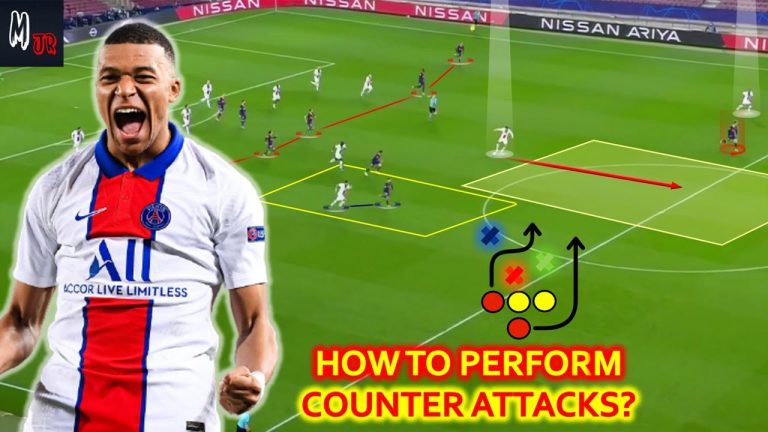Counterattacking is one of the most exciting aspects of soccer, able to quickly turn a defensive phase into a lethal threat for opponents. Here, we will explore the 10 formations that have defined this style of play, describing their history, evolution in modern soccer, and how each can be used effectively.
Here we also provide a video with plenty of information about counter attacking formations for football, whether it’s in eFootball or FC24:
The 10 Best Formations for Counterattacking in Soccer, e-Football and FC 24
1. Counter attacking Tactics: 4-4-2
The 4-4-2 is perhaps the most iconic formation in modern soccer, developed mainly in the 1980s and 1990s.
Its strength lies in simplicity and balance, with a well-supported defensive line of four players and an equally compact midfield. It is perfect for rapid counterattacks thanks to the presence of two forwards who are always ready to exploit opportunities.
Teams like Diego Simeone’s Atletico Madrid have turned the 4-4-2 into an art, making it a counterattacking machine. The strategy is to recover the ball in defense and immediately launch the two forwards, with midfielders ready to support the offensive action.
Pros:
- Balance: Provides a good balance between defense and attack.
- Ease of Understanding: Easy for players to learn and use.
- Defensive Solidity: Two lines of four make it difficult for opponents to find space.
- Great for Counterattacks: The two strikers are always ready to take advantage of transition opportunities.
Cons:
- Lack of Creativity: Limited presence in the midfield for controlling the ball and building play.
- Dependence on Forwards: Offensive actions often rely solely on the two strikers.
2. Counter attacking Tactics: 4-3-3
The 4-3-3 is a very versatile formation, made famous by Johan Cruyff’s Barcelona and later used by coaches like Pep Guardiola. It focuses on creating numerical superiority in the midfield, with wingers supporting the central striker. For an effective counterattack, the 4-3-3 allows for quick ball recovery, with midfielders joining in to create scoring opportunities while the wide players attack with speed. The 4-3-3 is ideal for teams that want to press high and also quickly transition, exploiting the wings.
Pros:
- High Offensive Potential: Three attackers apply constant pressure on the opponent’s defense.
- Versatility: Suitable for both ball possession and quick transitions.
- Support in Attack: Wide players create many passing options.
Cons:
- Requires Dynamic Players: Midfielders need to be very active both defensively and offensively.
- Defensive Vulnerability: The team can be left unbalanced during opponent counterattacks.
3. Counter attacking Tactics: 3-5-2
The 3-5-2 formation has evolved over recent decades thanks to coaches like Antonio Conte. Its strength lies in tactical flexibility and midfield control. The three center-backs provide defensive stability, while the five midfielders, including the two wingbacks, can quickly transition from defense to attack. The wingbacks are crucial for counterattacks, pushing forward to create superiority on the flanks and providing support to the strikers. This formation is highly effective in keeping the midfield compact, recovering the ball, and pushing forward immediately with the wingbacks.
Pros:
- Midfield Control: Five midfielders ensure control of the middle of the field.
- Overlapping Offensives: The wingbacks can push forward, creating an overload on the flanks.
- Compact Defense: Three center-backs provide solid coverage.
Cons:
- Demanding for Wingbacks: Wingbacks must cover the entire flank.
- Vulnerable on the Flanks: If the wingbacks do not track back quickly, there can be gaps for opponents on the wings.
4. Counter attacking Tactics: 4-5-1
The 4-5-1 is a defensive formation, often used by teams facing technically superior opponents. Its strength is in its ability to close spaces in the midfield and defend compactly. In counterattacks, the 4-5-1 can be lethal if the lone forward is fast and skilled at exploiting the few opportunities available, supported by midfielders who push forward to create offensive opportunities. This formation offers a good balance between defense and attack and, despite the presence of only one striker, can be very dangerous during transitions.
Pros:
- Defensive Compactness: Five midfielders make it possible to close down space in the midfield.
- Great for Counterattacks: Rapid transitions can be effectively utilized with the support of midfielders.
- Ideal Against Stronger Teams: Perfect for sitting deep and waiting for the right moment to strike.
Cons:
- Limited Offensive Presence: The lone striker can become isolated and may lack support.
- Dependence on Attacking Midfielders: Relies heavily on midfielders making runs to create scoring chances.
5. Counter attacking Tactics: 5-3-2
The 5-3-2 is a defensive formation that works well for counterattacks. With five defenders, it ensures a solid backline, while the two wingbacks can push forward when the team regains possession. This creates a quick transition from defense to attack, with the wingbacks supporting the midfield and forwards. Used by teams like Thomas Tuchel’s Chelsea, the 5-3-2 is ideal for closing down space and exploiting counterattacks, with the two strikers able to stretch the opposing defense.
Pros:
- Solid Defense: Five defenders ensure strong coverage, useful against teams with high offensive potential.
- Counterattacking Potential: The two strikers can exploit spaces left by opponents, with support from the wingbacks.
- Wingback Versatility: Wingbacks can attack and create numerical superiority.
Cons:
- Limited Creativity in Midfield: Only three midfielders limit possession control.
- High Physical Demand on Wingbacks: Wingbacks need to function as both defenders and attackers, which is physically demanding.
6. Counter attacking Tactics: 4-1-4-1
The 4-1-4-1 is a formation that relies on solid defense and a compact midfield. The defensive midfielder (CDM) adds extra coverage in front of the backline, while the four midfielders can quickly support the lone forward. This formation has been used to counter teams with strong ball possession and allows for effective counterattacking by freeing up midfielders to attack. It is a formation that prioritizes defensive security but can be very dangerous in transition due to midfield support.
Pros:
- Defensive Stability: The defensive midfielder provides extra coverage for the defense.
- Compactness: Four midfielders offer solid structure both defensively and offensively.
- Versatile in Transitions: Good for recovering the ball and transitioning, with a defensive midfielder freeing up others to attack.
Cons:
- Only One Forward: The forward can become isolated, especially when the team is under pressure.
- Dependence on Midfielders: Requires highly dynamic midfielders to ensure offensive support.
7. Counter attacking Tactics: 4-2-3-1
The 4-2-3-1 is one of the most popular formations for teams seeking both a solid defense and offensive options. Two defensive midfielders provide a solid barrier, while the three attacking players behind the striker create multiple attacking options. This formation has been widely used by José Mourinho in his best years, relying on defensive solidity and the ability to turn defense into attack. The playmaker behind the striker is key, as they can handle the transition and serve their teammates in the attacking phase.
Pros:
- Perfect Balance: The two defensive midfielders provide solidity, while the attacking trio supports the striker.
- Multiple Offensive Options: The three behind the striker offer various options, making it hard for the defense to predict the play.
- Good Defensive Pressing: The attacking midfielders can press the opponent’s defense, forcing errors.
Cons:
- Requires Versatile Midfielders: The two defensive midfielders need to support both defense and initiate the attack.
- Vulnerable to Counterattacks: If possession is lost, the team can become unbalanced.
8. Counter attacking Tactics: 3-4-3
The 3-4-3 is an attacking formation that adapts well to situations where a team wants to dominate but can also counterattack quickly. With three center-backs and four midfielders, including two offensive wingbacks, the 3-4-3 can easily switch from a defensive phase to an attacking one. Antonio Conte made this formation famous during his time at Chelsea, using it to exploit the wingbacks, who become additional attackers, creating numerical superiority in the attacking phase.
Pros:
- High Offensive Potential: With three attackers and two wingbacks, there is strong pressure on the opponent’s defense.
- Overlap on the Wings: Wingbacks can push forward, creating overloads on the flanks.
- Tactical Flexibility: Easy to switch from defense to attack.
Cons:
- Requires Agile Center-Backs: The three defenders must be quick and able to cover wide areas.
- Space on the Flanks: If the wingbacks do not track back, opponents can exploit the flanks.
9. Counter attacking Tactics: 4-3-1-2
The 4-3-1-2 is a formation used to control the midfield and create a tight and vertical style of play. It was employed by Luciano Spalletti’s Roma. This formation works well for counterattacking because the playmaker is free to move between the lines and serve precise passes to the strikers. The three midfielders work hard to recover the ball and support the playmaker, ensuring an effective transition from defense to attack.
Pros:
- Midfield Control: Three central midfielders plus a playmaker ensure control of the middle of the pitch.
- Strong Central Presence: Ideal for teams that want to attack centrally, with two strikers always ready to receive the ball.
- Playmaker as the Key Player: The playmaker offers creativity and can manage the transition between defense and offense.
Cons:
- Lack of Width: Lack of wingers to spread the play, making the team more predictable.
- Demanding for Midfielders: Midfielders must be capable of covering both defensive and attacking duties.
10. Counter attacking Tactics: 5-4-1
The 5-4-1 is an ultra-defensive formation, ideal when a team wants to defend a lead or face a superior opponent. With five defenders and four midfielders, this formation offers great protection for the defense. The lone striker becomes crucial in exploiting the few counterattacking opportunities, often relying on their speed and ability to hold the ball. Used by teams like Iceland during Euro 2016, the 5-4-1 is perfect for defending deep and then countering quickly.
Pros:
- Compact Defense: Five defenders and four midfielders make it difficult for opponents to find space.
- Great for Defending Leads: Ideal for protecting a lead or facing a stronger team.
- Speed on the Counter: The lone forward must be very fast, taking advantage of any opportunity to counterattack.
Cons:
- Limited Offensive Presence: Only one striker means few attacking options, relying heavily on counterattacking opportunities.
- Difficulty Keeping Possession: With many players behind the ball, the team may struggle to maintain possession and build sustained attacks.
There are different tactics you could adopt to execute a counter attack in football, but the truth is that none of them is infallible; it all depends on how you use it when playing—whether you’re part of a conventional football team or in the realm of eSports. The reality is that if you know how to play your cards right or move your players at the right moment, that will be the best counter attack formation for you.




